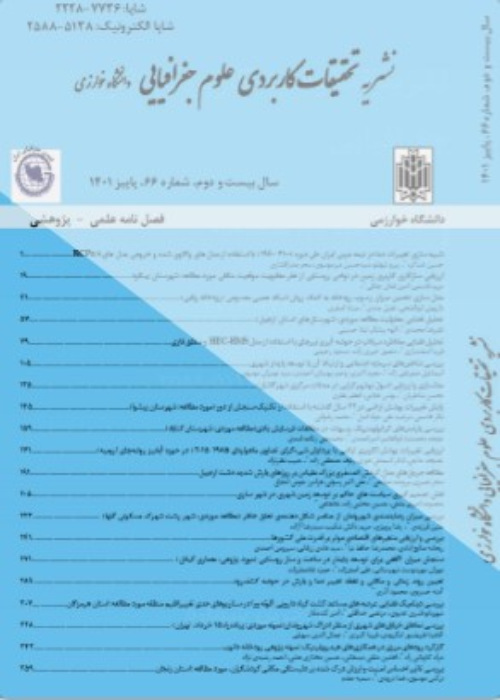Investigating the causes of groundwater leakage in Nahabad Mamsan plain using geomorphic indices based on geo Dualiteh theory
Author(s):
Article Type:
Research/Original Article (دارای رتبه معتبر)
Abstract:
In evaluating and studying natural phenomena, we sometimes encounter certain seemingly independent forms and processes and phenomena that are related to each other and can be analyzed through a series of mathematical equations and correlations, but sometimes paired phenomena It is found that they have certain relations with each other, but these relationships can not be called correlation, but their relationship has caused them to be presented as a double (a type of conjugacy) and they would appear to be opposing reactions in terms of collocation. The tectonic changes, especially the neonate movements, and its effects and consequences on groundwater reserves of these types of reactions. The purpose of this study is to investigate causes of groundwater drops in the framework of geodetic theory. With regard to the fact that in recent years, the water level in the northern plain of Mangasani has fallen sharply. Undoubtedly, non-structural activities in the region, along with other influential factors (uncontrolled harvesting of groundwater resources, droughts, etc.), can be attributed to The title is one of the main causes of water loss in the region. For this purpose, with the aim of evaluating the tectonic activity of the area, some geomorphic indices such as basin shape index (BS), drainage asymmetry index (AF), inverse topographic symmetry (T), mountain front sinus index (J), hypersonic integral (Hi), Valley Depth Wide Index (VF), River Sinusity Index (S), Longitudinal River Gradient (SL), Relative Tactical Rating Index (Iat), and Hierarchical Anomalies Index (Δa) have been used. The results show that the whole basin is dynamic in terms of tectonic activity. The tectonic situation in the range and the results of statistical data indicate a change in the level of groundwater table as a result of tectonic changes in the southern plain of Nur Abad, as evidenced by the fact that the depth of the station was 89 meters less than 82 meters The highest drop in the Khomeghar well is about 26 meters in the southern part of the basin, in line with Kazeroon's active fault.
Keywords:
Language:
Persian
Published:
Journal of Applied Researches in Geographical Sciences, Volume:19 Issue: 52, 2018
Pages:
235 to 254
magiran.com/p1905669
دانلود و مطالعه متن این مقاله با یکی از روشهای زیر امکان پذیر است:
اشتراک شخصی
با عضویت و پرداخت آنلاین حق اشتراک یکساله به مبلغ 1,390,000ريال میتوانید 70 عنوان مطلب دانلود کنید!
اشتراک سازمانی
به کتابخانه دانشگاه یا محل کار خود پیشنهاد کنید تا اشتراک سازمانی این پایگاه را برای دسترسی نامحدود همه کاربران به متن مطالب تهیه نمایند!
توجه!
- حق عضویت دریافتی صرف حمایت از نشریات عضو و نگهداری، تکمیل و توسعه مگیران میشود.
- پرداخت حق اشتراک و دانلود مقالات اجازه بازنشر آن در سایر رسانههای چاپی و دیجیتال را به کاربر نمیدهد.
In order to view content subscription is required
Personal subscription
Subscribe magiran.com for 70 € euros via PayPal and download 70 articles during a year.
Organization subscription
Please contact us to subscribe your university or library for unlimited access!



